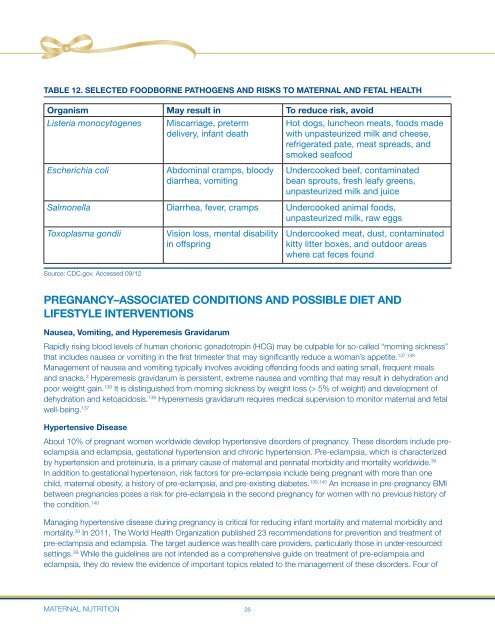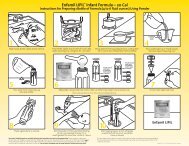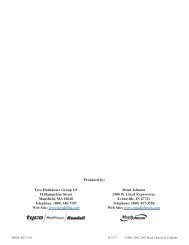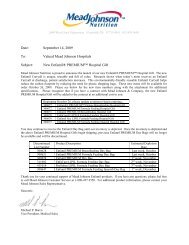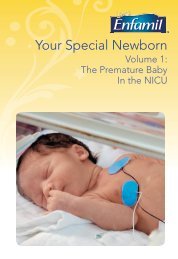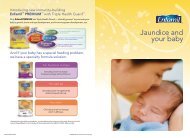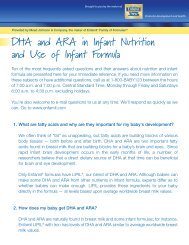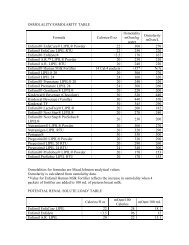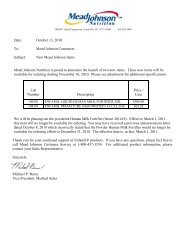LB2882MaternalNutriti+ - Mead Johnson Nutrition
LB2882MaternalNutriti+ - Mead Johnson Nutrition
LB2882MaternalNutriti+ - Mead Johnson Nutrition
You also want an ePaper? Increase the reach of your titles
YUMPU automatically turns print PDFs into web optimized ePapers that Google loves.
TAbLE 12. SELECTED FOODbORNE PATHOGENS AND RISkS TO MATERNAL AND FETAL HEALTH<br />
Organism May result in To reduce risk, avoid<br />
Listeria monocytogenes Miscarriage, preterm<br />
delivery, infant death<br />
Hot dogs, luncheon meats, foods made<br />
with unpasteurized milk and cheese,<br />
refrigerated pate, meat spreads, and<br />
smoked seafood<br />
Escherichia coli<br />
Abdominal cramps, bloody<br />
diarrhea, vomiting<br />
Undercooked beef, contaminated<br />
bean sprouts, fresh leafy greens,<br />
unpasteurized milk and juice<br />
Salmonella Diarrhea, fever, cramps Undercooked animal foods,<br />
unpasteurized milk, raw eggs<br />
Toxoplasma gondii<br />
Vision loss, mental disability<br />
in offspring<br />
Undercooked meat, dust, contaminated<br />
kitty litter boxes, and outdoor areas<br />
where cat feces found<br />
Source: CDC.gov. Accessed 09/12<br />
PREGNANCY–ASSOCIATED CONDITIONS AND POSSIbLE DIET AND<br />
LIFESTYLE INTERVENTIONS<br />
Nausea, Vomiting, and Hyperemesis Gravidarum<br />
Rapidly rising blood levels of human chorionic gonadotropin (HCG) may be culpable for so-called “morning sickness”<br />
that includes nausea or vomiting in the fi rst trimester that may signifi cantly reduce a woman’s appetite. 137,138<br />
Management of nausea and vomiting typically involves avoiding offending foods and eating small, frequent meals<br />
and snacks. 3 Hyperemesis gravidarum is persistent, extreme nausea and vomiting that may result in dehydration and<br />
poor weight gain. 138 It is distinguished from morning sickness by weight loss (> 5% of weight) and development of<br />
dehydration and ketoacidosis. 138 Hyperemesis gravidarum requires medical supervision to monitor maternal and fetal<br />
well-being. 137<br />
Hypertensive Disease<br />
About 10% of pregnant women worldwide develop hypertensive disorders of pregnancy. These disorders include preeclampsia<br />
and eclampsia, gestational hypertension and chronic hypertension. Pre-eclampsia, which is characterized<br />
by hypertension and proteinuria, is a primary cause of maternal and perinatal morbidity and mortality worldwide. 39<br />
In addition to gestational hypertension, risk factors for pre-eclampsia include being pregnant with more than one<br />
child, maternal obesity, a history of pre-eclampsia, and pre-existing diabetes. 139,140 An increase in pre-pregnancy BMI<br />
between pregnancies poses a risk for pre-eclampsia in the second pregnancy for women with no previous history of<br />
the condition. 140<br />
Managing hypertensive disease during pregnancy is critical for reducing infant mortality and maternal morbidity and<br />
mortality. 39 In 2011, The World Health Organization published 23 recommendations for prevention and treatment of<br />
pre-eclampsia and eclampsia. The target audience was health care providers, particularly those in under-resourced<br />
settings. 39 While the guidelines are not intended as a comprehensive guide on treatment of pre-eclampsia and<br />
eclampsia, they do review the evidence of important topics related to the management of these disorders. Four of<br />
MATERNAL NUTRITION 26


